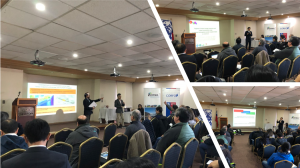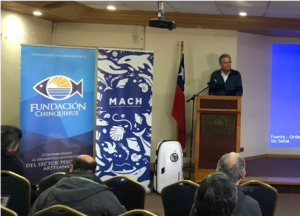At the beginning of September 2019, we invited three professors to Chile, Dr. Yoshihiro Ito (associate professor of Kyoto University, Disaster Prevention Research Institute; link), Dr. Kei Yoshimura (professor of the University of Tokyo, Institute of Industrial Science; link), and Dr. Shinji Nakaoka (lecturer of Hokkaido University, Graduate School of Life Sciences; link), to present lectures to Chilean communities. Dr. Ito is the Japanese leader of the earthquake research project that is proceeding in Mexico (link) on the same framework as our MACH project, the SATREPS International Science and Technology Cooperation Program. Dr. Yoshimura and Dr. Nakaoka are collaborating with our project (link).
On September 3, we held a seminar at Castro, Chiloé, which was co-organized with CETMIS and Chinquihue Foundation (see below about them). Audiences included local mussel farmers, researchers, INTEMIT and technical staff from local aquaculture companies.

Dr. Ito talked how they are constructing an observation system for a seismic blank area in Mexico, and how simulation of tsunami tells a better evacuation behavior to escape from the attack of tsunami. He also talked about training programs for tsunami evacuation in cooperation with regional administrations, schools, companies in public infrastructure and so on. Following the talk, Dr. Maruyama, the Japanese leader of this MACH project, introduced the purpose and progress of our project.
Dr. Nakaoka explained plainly how we can understand the behavior of ecosystems by formulating basic properties such as growth rates and competition between organisms mathematically. He exemplified how broadly such theoretical studies are applicable to different phenomena that would include harmful algae bloom. The talk of Dr. Yoshimura also enabled beginners to follow the background of theory, modeling, and simulation in the field of geophysics. He emphasized the accuracy of prediction is greatly improved by combining the atmosphere model and the ocean model together. They then explained the prospect to further incorporate biological data into the model, which will advance this project.
From our project, participated were Dr. Andrés Ávila (professor of UFRO, CEMCC (link) and one of the researchers of our project from Chile (link)), Dr. Shoko Ueki (associate professor of Okayama University and one of Research Associate Directorsof this project), Dr. Mikihiko Kawai, and project coordinator Yuji Misu, in addition to Dr. Maruyama.

(Oscar Leibbrandt Fehrmann, General Manager Chinquihue Foundation)
————–
Chinquihue Foundation (link) is a private non-profit organization that aims to promote the development of artisanal fisheries and small-scale aquaculture. Chinquihue Foundation also executes CETMIS (Centro de Extensionismo Tecnológico para una Mitilicultura Sustentable; link), which is an organization dedicated to delivering technical assistance and technical transfer to micro, small and medium-sized companies of mussel farming. Chinquihue Foundation was originally established on 1989 as an organization that manages a fishery market (Complejo Pesquero) donated by Japan’s ODA (Official Development Assistance). Since then, Chinquihue Foundation has, while keeping its mission to improve regional artisanal fisheries and mussel aquaculture, continuously developed its activities through funding from government such as CORFO (Corporación de Fomento de la Producción) and regional state government. The history of Chinquihue Foundation could be a good example how outcome of our MACH project will be continuously used in the future after the period of this project is over.